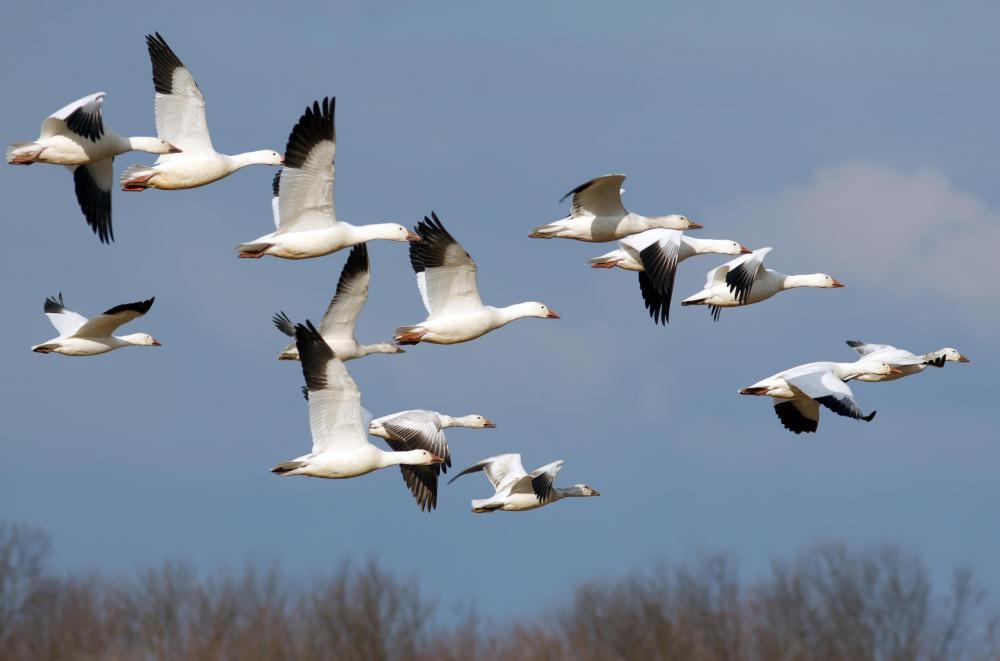
It’s happening to catbirds and hummingbirds, too, said Fred Buse, a Penn State master gardener and naturalist. “They should be south at this time of year, but we don’t have any snow to push them.” “They found out that eastern Pennsylvania is a great place to winter,” he said. Changes in climate and agriculture have pushed their exploration inland, whereas they typically wintered along the coasts. In the last two decades, they’ve come to the Lehigh Valley in search of the region’s winter wheat and abundance of corn stubble, Saenger has observed. “It’s like being in New York City rush hour traffic in the middle of nowhere,” Saenger said. Now the geese leave earlier because of warmer winters up north, and it’s a giant tourist attraction.

In the early 2000s, only the most dedicated bird enthusiasts took the mud trail to the viewing point at the Middle Creek Wildlife Management Area in Lancaster County in mid-March, the prime time to see the most snow geese gather together on the lake before flying north. Most of Pennsylvania was too snowy and icy for them during the coldest months, but the commonwealth was a stop on the way south and the way back north as winter thawed. It was 30 years, 8 months old and was originally banded in Arizona in 1990.Snow geese once would spend the winter south of Pennsylvania, from coastal Virginia and the Delaware Bay shore down as far as South Carolina, he said.

The oldest Snow Goose on record, a blue morph, was shot in Idaho in 2020.Since then, their populations have continued to grow, to the point that some areas of tundra nesting habitat are starting to suffer. Hunting was allowed again in 1975 after populations had recovered. Snow Goose hunting in the eastern United States was stopped in 1916 because of low population levels.The defecation rate is highest when a goose is grubbing for rhizomes, because such food is very high in fiber and the goose inevitably swallows mud. Food passes through the Snow Goose’s digestive tract in only an hour or two, generating 6 to 15 droppings per hour.Females forage up to 18 hours a day once they arrive at breeding grounds, but eat little once they begin incubating the eggs.Molting Snow Geese can outrun many predators. Within the first three weeks of hatching, goslings may walk up to 50 miles with their parents from the nest to a more suitable brood-rearing area. Snow Geese make epic journeys by air, but they are impressive on foot, too.Upon sighting a threat they call out to the rest of the flock, which may take flight. In wintering and migrating flocks that are feeding, lookouts keep an eye out for eagles and other predators.

People can sometimes tell what order the eggs were laid in, just by the color of the shells (the dirtiest shells belong to the oldest eggs). The creamy white eggs of Snow Geese stain easily.They grow very quickly, with the males outpacing the females. Within a few days they are able to maintain a constant body temperature on their own. Snow Geese chicks are well developed when they hatch, with open eyes and down-covered bodies that already show whether the adult will have white or dark plumage.If two dark geese mate, they will have mostly dark offspring, but might have a few white ones too. If two white geese mate, they have only white offspring. If a pure dark goose mates with a white goose, the offspring will all be dark (possibly with white bellies). The dark color of the blue morph Snow Goose is controlled by a single gene, with dark being partially dominant over white.


 0 kommentar(er)
0 kommentar(er)
